4 Aluminum Elbow
In piping systems, "4 Aluminum Elbow" typically refers to an aluminum elbow with a nominal diameter of 4 inches (DN100). The "4" represents the nominal diameter of the elbow in inches, corresponding to DN100 (nominal diameter 100 mm) in the metric system. Aluminum elbows are fittings made of aluminum alloy materials used to change the direction of the pipeline.
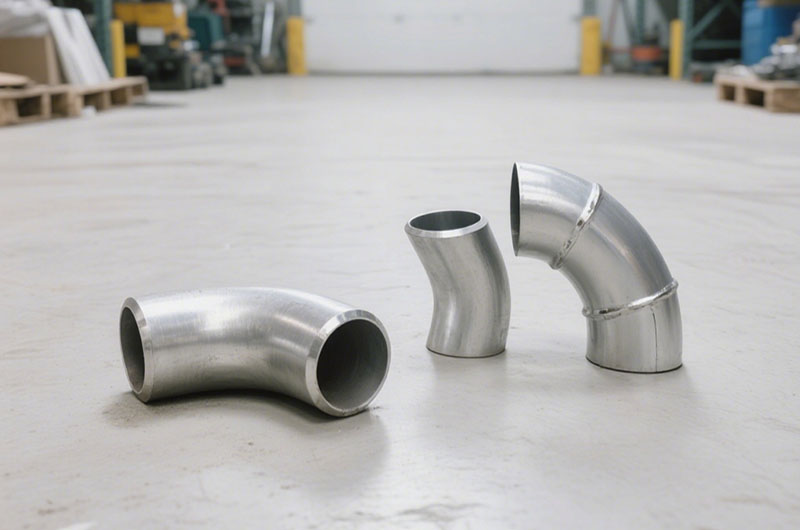
- Common alloys: 6061-T6 (high strength, weldable), 6063 (smoother surface, suitable for extrusions).
- Advantages: lightweight, corrosion-resistant, suitable for HVAC, exhaust, and marine applications.
- Wall thickness: Schedule 5/10 (lightweight), Schedule 40 (standard) depending on pressure/temperature requirements.
- Angle: usually 90° (standard), but also available in 45°, 30°, or custom angles.
The 4 Aluminum Elbow is widely used in the shipbuilding and marine engineering industries mainly due to the following aspects:
- Seawater corrosion resistance: 5083 aluminum alloy elbow offers excellent corrosion resistance in marine environments
- Lightweight: aluminum elbows are lightweight, reducing the overall weight of ships and marine platforms
- Fatigue resistance: aluminum elbows perform well under vibration and impact environments
- Temperature resistance: aluminum elbows remain stable in various temperature conditions
As a trusted aluminum fittings supplier, HC Aluminum focuses on providing various mainstream sizes of marine-grade aluminum elbows to meet the installation requirements of different marine systems.
- Material identification: commonly used aluminum materials include 1060, 6061, 6063, 5083, etc.
- Nominal diameter: expressed in inches or DN, e.g., 4"(100)
- Bending angle: commonly 45°, 90°, 180°, etc.
- Connection type: butt weld, socket weld, threaded connection, etc.
- Manufacturing process: commonly by casting, etc.
Our aluminum elbows are made of high-quality marine-grade aluminum alloys with excellent corrosion resistance, lightweight structure, and reliable mechanical strength. They are widely used in ship engine cooling systems, seawater pipelines, ventilation, and exhaust systems. The products are certified by classification societies such as ABS, DNV, and CCS to ensure safety and long-term operation.
Main Classification Methods of 4 Aluminum Elbow
4 Aluminum Elbow can be classified in various ways, mainly including the following:
Classification by Bending Angle
- 90° Elbow: the most commonly used elbow type, used to achieve vertical direction changes in piping
- 45° Elbow: used to make gentle directional changes in piping, with a smoother angle
- 180° Elbow: also known as return elbow, used for 180° turns to reverse fluid flow
- Special angle elbows: other non-standard angle elbows such as 60° based on engineering requirements
Classification by Bending Radius
- Long Radius Elbow (LR): bending radius is 1.5 times the nominal diameter, i.e., R=1.5D
- Short Radius Elbow (SR): bending radius is equal to the nominal diameter, i.e., R=D
- Extra Long Radius Elbow: bending radius greater than 1.5D, such as 2D, 3D, etc., for custom products
Classification by Connection Method
- Butt Weld Elbow: connected to the pipeline by direct welding, commonly used in high-pressure piping systems
- Socket Weld Elbow: inserted into the socket end of the pipe for welding, suitable for small-diameter pipelines
- Threaded Elbow: connected by threading, convenient for installation and disassembly
- Flanged Elbow: connected with the pipeline via flange, convenient for inspection and maintenance
- Push-fit Elbow: directly inserted connection, commonly used in low-temperature or low-pressure systems
Classification by Manufacturing Process
- Cast Elbow: manufactured by casting process, suitable for complex-shaped elbows
- Welded Elbow: made by welding multiple parts, suitable for large-diameter elbows
Classification by Material
- Pure Aluminum Elbow: such as 1060 pure aluminum elbow, with good corrosion resistance and conductivity
- Aluminum Alloy Elbow: such as 6061 aluminum alloy elbow, 6063 aluminum alloy elbow, with high strength and corrosion resistance
- Corrosion-resistant Aluminum Alloy Elbow: such as 5083 aluminum elbow, with excellent resistance to seawater corrosion
- High-strength Aluminum Alloy Elbow: such as 6082 aluminum elbow, with high strength and good machinability
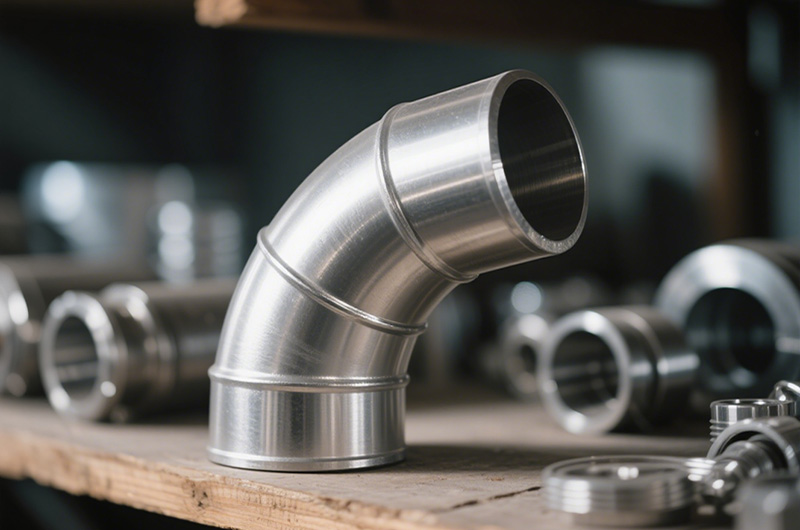
4 Aluminum Elbow Size Specifications
Nominal Sizing Systems of 4 Aluminum Elbow
The nominal sizing of 4 aluminum elbows mainly adopts two systems:
- Imperial Sizing System: uses inches as the unit, marked as NPS (Nominal Pipe Size)
- Metric Sizing System: uses millimeters as the unit, marked as DN (Nominal Diameter)
For 4 aluminum elbows, the nominal size corresponds as follows:
| Nominal Diameter (DN) | Nominal Diameter (NPS) | Outer Diameter (OD) | Approx. Inner Diameter (ID) |
| 100mm | 4" | 108mm or 114.3mm | Approx. 100mm |
Dimensional Parameters of 4 Aluminum Elbows with Different Bending Angles
90° Elbow Dimensional Parameters
The 90° elbow is the most commonly used type. Its main dimensional parameters include:
- Center to Face (C/F): For long radius elbows, it is 1.5 times the nominal diameter (1.5D); for short radius elbows, it is equal to the nominal diameter (D)
- Outer Diameter (OD): The outer diameter of a 4" elbow is typically 114.3mm
- Bending Radius (R): Long radius elbow is 1.5D (approx. 152.4mm), short radius elbow is D (approx. 101.6mm)
- Wall Thickness (T): Varies depending on operating pressure and standard, commonly Sch40, Sch80, etc.
The following table lists the main dimensional parameters of 4" 90° elbows according to ASME B16.9 standard:
| Nominal Diameter (NPS) | Outer Diameter (OD) | Center to Face (C/F) | Bending Radius (R) | Common Wall Thickness (Sch) |
| 4" | 114.3mm | 152.4mm (Long Radius) | 152.4mm (Long Radius) | Sch10, Sch40, Sch80 |
| 4" | 114.3mm | 101.6mm (Short Radius) | 101.6mm (Short Radius) | Sch10, Sch40, Sch80 |
45° Elbow Dimensional Parameters
The main dimensional parameters of 45° elbows include:
- Center to Face (C/F): For long radius elbows, it is approximately 0.75 times the nominal diameter, i.e., 0.75D; for short radius elbows, it is approximately 0.5 times the nominal diameter, i.e., 0.5D
- Bending Radius (R): Same as 90° elbows, long radius is 1.5D, short radius is D
- Other parameters: such as outer diameter and wall thickness, are the same as those of 90° elbows
The following table shows the main dimensional parameters of 4" 45° elbows according to ASME B16.9 standard:
| Nominal Diameter (NPS) | Outer Diameter (OD) | Center to Face (C/F) | Bending Radius (R) | Common Wall Thickness (Sch) |
| 4" | 114.3mm | 76.2mm (Long Radius) | 152.4mm (Long Radius) | Sch10, Sch40, Sch80 |
| 4" | 114.3mm | 50.8mm (Short Radius) | 101.6mm (Short Radius) | Sch10, Sch40, Sch80 |
180° Elbow (Return Elbow) Dimensional Parameters
The 180° elbow, also known as a return elbow, has the following main dimensional parameters:
Center to Face (C/F): For long radius elbows, it is 3 times the nominal diameter, i.e., 3D; for short radius elbows, it is 2 times the nominal diameter, i.e., 2D Bending Radius (R): Same as 90° elbows, long radius is 1.5D, short radius is D Other parameters: such as outer diameter and wall thickness, are the same as those of 90° elbows
Dimensional Differences of Elbows by Connection Type
4" aluminum elbows with different connection types also exhibit certain dimensional differences:
Dimensional Features of Butt Weld 4 Aluminum Elbow
- Bevel Size: Butt weld elbows usually have beveled ends for convenient welding connection
- Wall Thickness Range: Butt weld elbows typically have thicker walls, commonly Sch40, Sch80, etc.
- Length Dimensions: Compared with other connection types, the length dimensions of butt weld elbows mainly depend on bending angle and radius, and are not significantly affected by connection type
Dimensional Features of Socket Weld 4 Aluminum Elbow
- Socket Size: One end of a socket weld elbow has a socket to insert the pipe for welding
- Socket Depth: Usually 1–2 times the wall thickness
- Applicable Pipe Diameter: Socket weld elbows are typically used for smaller diameter pipes; 4" socket weld elbows are relatively uncommon
Dimensional Features of Threaded 4 Aluminum Elbow
- Thread Specification: Threaded elbows come with internal or external threads for threaded connections
- Thread Length: Depends on thread standards such as NPT
- Applicable Pressure: Threaded elbows are typically used in low-pressure systems
Dimensional Features of Flanged 4 Aluminum Elbow
- Flange Dimensions: Flanged elbows have one or both ends fitted with flanges for flange connections
- Flange Standards: Common standards include ASME B16.5, BS 4504, etc.
- Flange Thickness: Varies depending on pressure ratings
Dimensional Parameters for Different Wall Thickness Schedules
The wall thickness of aluminum elbows is usually expressed in Sch (Schedule) ratings. Common wall thickness grades include Sch10, Sch40, Sch80, etc. For 4" aluminum elbows, the dimensional parameters for different wall thickness schedules are as follows:
| Wall Thickness Grade (Sch) | Wall Thickness (mm) | Approximate Inner Diameter (mm) | Applicable Pressure Range (MPa) |
| Sch10 | 3.05 | 108.2 | Low Pressure (≤1.0 MPa) |
| Sch40 | 6.02 | 102.26 | Medium Pressure (1.0–4.0 MPa) |
| Sch80 | 7.82 | 98.66 | Higher Pressure (4.0–10.0 MPa) |
| Sch160 | 11.13 | 92.04 | High Pressure (10.0–20.0 MPa) |
| XXS | 15.64 | 83.02 | Ultra-High Pressure (≥20.0 MPa) |
Dimensional Differences by Material Type
4" aluminum elbows made of different materials are generally the same in size, but differ in weight and mechanical properties:
- Pure Aluminum Elbow (e.g., 1060): Lower density and lighter weight, suitable for light load and corrosion-resistant environments
- 6061 Aluminum Alloy Elbow: Higher strength and moderate weight, suitable for general structural and mechanical applications
- 6063 Aluminum Alloy Elbow: Excellent corrosion resistance and good surface finish, suitable for decorative and architectural applications
- 5083 Aluminum Alloy Elbow: High strength and excellent resistance to seawater corrosion, ideal for marine environments and high-strength structures
4 Aluminum Elbow Applications
Applications by Bending Angle
Applications of 90° Elbows
90° elbows are the most commonly used type and widely applied in the following areas:
- Building Piping Systems: Used for directional changes in water supply, drainage, heating, and HVAC systems, especially at right-angle turns
- Chemical Piping Systems: For corrosive media transport in chemical plants, especially where right-angle turns are needed
- Marine Piping Systems: Widely used in seawater, fuel, and cooling water pipelines on ships
- Refrigeration Equipment: For connecting evaporators, condensers, etc., to achieve right-angle directional changes
- Air Separation Equipment: Used in cryogenic pipeline systems to convey and redirect gases
Applications of 45° Elbows
Although 45° elbows are less common, they serve irreplaceable functions in certain applications:
- Long-Distance Piping: Reduce fluid resistance and pressure loss over long distances
- Systems Requiring Smooth Direction Changes: Such as hydraulic and lubrication systems
- Vibrating Piping Systems: Reduce stress concentration and improve reliability
- Noise-Sensitive Environments: Help reduce fluid impact noise
Applications of 180° Elbows (Return Elbows)
180° elbows are mainly used in the following scenarios:
- Systems Requiring 180° Fluid Reversal: For example, systems that need to reverse the direction of flow
- Space-Constrained Systems: Enable compact piping layouts
- Heat Exchangers and Condensers: For connecting pipes and redirecting or distributing flow
- Systems Requiring U-Bends: Such as expansion loops and compensators
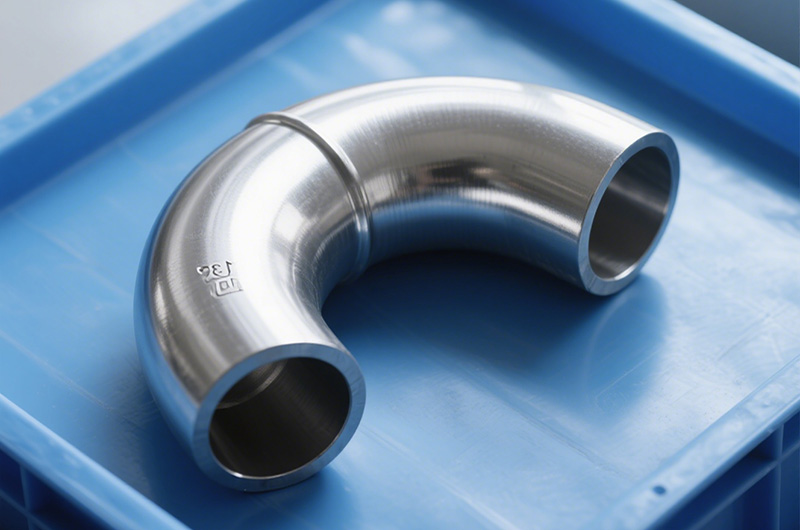
Applications by Connection Type
Applications of Butt Weld Elbows
Butt weld elbows are among the most widely used types, mainly used in:
- High-Pressure Piping Systems: Preferred for pressures ≥4.0 MPa
- High-Temperature Piping Systems: Offer superior strength and stability under high temperature
- Large-Diameter Piping Systems: Ideal for pipes with diameter ≥DN80 due to reliability and cost-effectiveness
- Demanding Industrial Systems: Widely used in petroleum, chemical, and power industries
Applications of Socket Weld Elbows
Socket weld elbows are mainly used in:
- Small-Diameter Piping Systems: Typically for diameters ≤DN50, more economical than butt weld
- Low-Pressure Piping Systems: Provide sufficient strength and sealing for pressures ≤1.6 MPa
- Systems Requiring Frequent Disassembly: More reliable than threaded connections
- Aesthetic Applications: Provide a smoother surface for applications with high visual requirements
Applications of Threaded Elbows
Threaded elbows are mainly used in:
- Systems Requiring Quick Assembly/Disassembly: Offer maximum convenience for frequent adjustments
- Low-Pressure and Ambient Systems: Cost-effective choice for pressures ≤1.0 MPa and ambient temperatures
- Small Equipment and Instruments: Widely used in compact setups and lab apparatus
- Systems with Frequent Layout Changes: Offer maximum flexibility in pipeline configuration
Application Fields of Flanged Elbows
Flanged elbows are mainly used in the following fields:
- Systems requiring frequent maintenance: In large equipment and pipeline systems that need regular disassembly and maintenance, flanged elbows offer maximum convenience
- High-pressure and high-temperature systems: In such environments, flanged elbows provide reliable connection and sealing
- Large industrial equipment: Widely used in reactors, towers, heat exchangers, and other industrial connections
- Isolated systems: In systems requiring isolation or sectional control, flanged elbows can be used in combination with valves
Application Fields by Manufacturing Process
Application Fields of Cast Elbows
Cast elbows are mainly used in the following fields:
- Large-diameter piping systems: Suitable for large diameters (≥DN200), especially non-standard pipe sizes
- Complex-shaped elbows: When special angles or complex shapes are needed, casting is often the only choice
- Low-pressure systems: Typically used for pressure ≤2.5 MPa due to potential internal micro-defects
- High-wear environments: In systems with solid particles or high abrasion, increased wall thickness in cast elbows can extend service life
Application Fields of Welded Elbows
Welded elbows are mainly used in the following fields:
- Large-diameter piping systems: Especially useful for diameters ≥DN300 and for on-site installations
- On-site fabricated elbows: Frequently used during construction for custom angles or dimensions
- Temporary pipeline systems: Welded elbows allow for quick fabrication and installation
- Repair and retrofit projects: Offer flexible solutions for modifying existing pipeline systems
Application Fields by Material Type
Application Fields of 6061 Aluminum Alloy Elbows
6061 aluminum alloy elbows are among the most widely used aluminum elbows and are mainly used in the following fields:
- General structural applications: With good strength and toughness, suitable for various structural uses
- Mechanical manufacturing: Used in transmission and connection systems
- Building structures: Applied in roofing and curtain wall systems, especially where high strength and corrosion resistance are required
- Marine and offshore engineering: After proper treatment, 6061 elbows can be used in non-seawater-contact areas of marine applications
Application Fields of 6063 Aluminum Alloy Elbows
6063 aluminum alloy elbows are mainly used in the following fields:
- Architectural decoration: Excellent surface finish for decorative purposes
- Window and door systems: Used in structural support and connections
- Furniture manufacturing: Especially in high-end furniture for both decorative and structural purposes
- Exhibitions and displays: Provide aesthetic and durable solutions for display structures
Application Fields of 5083 Aluminum Alloy Elbows
5083 aluminum alloy elbows offer excellent corrosion resistance and high strength, and are mainly used in:
- Marine and offshore engineering: Ideal due to superior seawater corrosion resistance
- Pressure vessels: Provide high strength and sealing in pressure tanks and storage systems
- Cryogenic systems: Maintain good mechanical properties under low-temperature conditions
- Chemical equipment: Especially in corrosive media, 5083 elbows ensure long service life
Application Fields of Pure Aluminum Elbows (e.g., 1060)
Pure aluminum elbows are mainly used in:
- High conductivity requirements: Excellent conductivity for grounding and shielding pipelines in electrical systems
- Food and beverage industry: Non-toxic and corrosion-resistant, suitable for food-grade pipelines
- Pharmaceutical industry: Meet hygiene requirements in production and delivery systems
- Decoration and construction: Suitable for surface-treated architectural and decorative applications
Application Cases of 4 Aluminum Elbows in Various Industries
Marine and Offshore Engineering Applications
- In the marine and offshore field, 4" aluminum elbows are mainly applied in:
- Ship seawater systems: Widely used in seawater cooling, ballast water, and fire protection systems, especially with 5083 aluminum alloy elbows
- Ship fuel systems: Used to connect fuel pumps, filters, and engines in fuel delivery and storage systems
- Ship lubricating oil systems: Connect lube oil coolers, filters, and engines
- Offshore platforms: Used in various pipeline systems requiring corrosion resistance and high strength
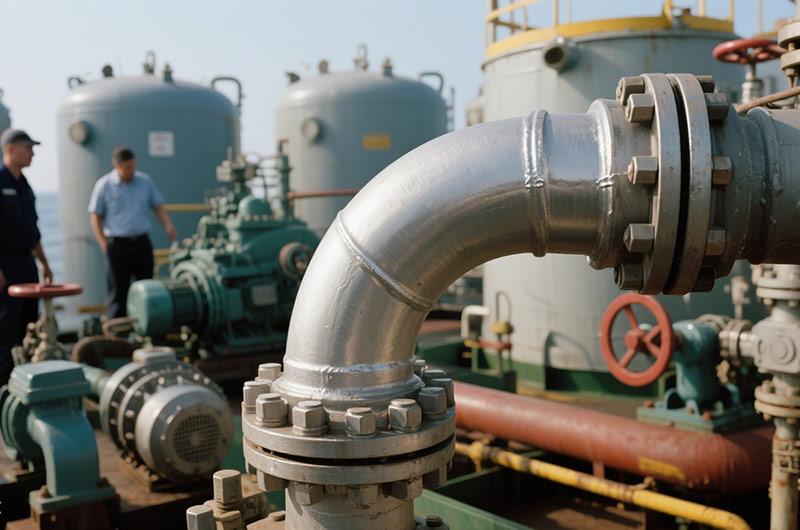
Application Cases in the Oil and Gas Industry
In the oil and gas industry, 4" aluminum elbows are mainly used in the following aspects:
- Oil and gas transmission pipelines: Used to change the direction of pipelines over long distances, especially in complex terrain
- Offshore platforms: 5083 aluminum alloy elbows are used in seawater pipelines, ballast water systems, and fire protection systems
- Refineries: Used in various process pipelines, particularly in corrosive environments
- Natural gas processing plants: Applied in gas transmission and processing systems
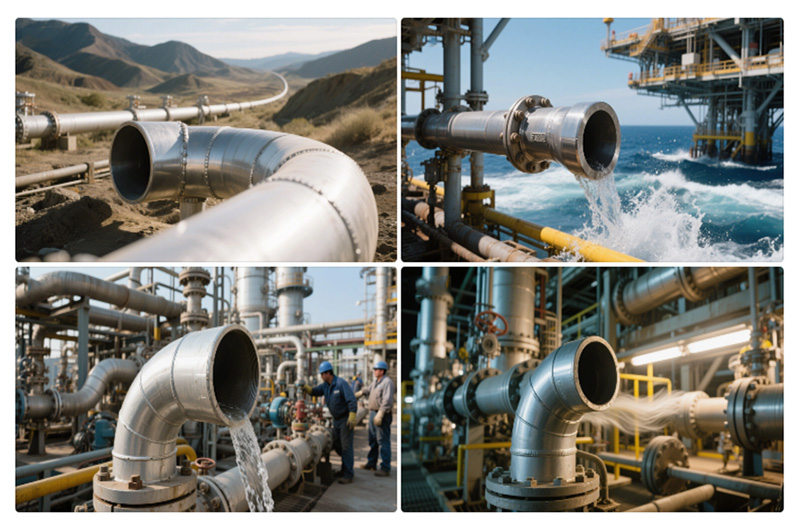
Application Cases in the Chemical Industry
In the chemical industry, 4" aluminum elbows are mainly used in the following aspects:
- Corrosive media transportation: Used to transport acids, alkalis, and salt solutions
- Reactors and vessels: Connect piping to change flow direction and link various equipment
- Distillation and rectification systems: Connect columns, condensers, and reboilers
- Chemical agent storage and delivery: Used in pipelines and tanks for various chemical agents
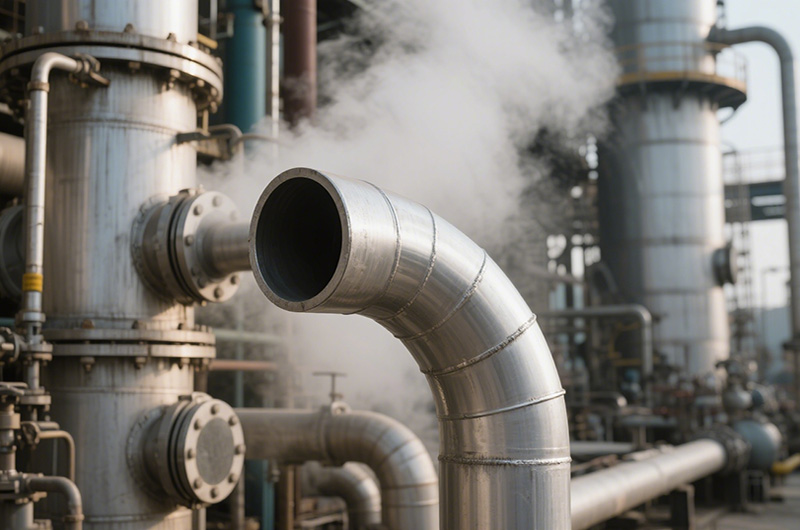
Application Cases in Construction and Municipal Engineering
In construction and municipal engineering, 4" aluminum elbows are mainly used in the following aspects:
- Building plumbing systems: Used to change pipe direction, especially in tight spaces
- Heating and air conditioning systems: Connect radiators, AC units, and fan coil units
- Fire protection systems: Connect fire pumps, water tanks, and sprinkler systems
- Municipal water supply systems: Connect water treatment plants, distribution networks, and users
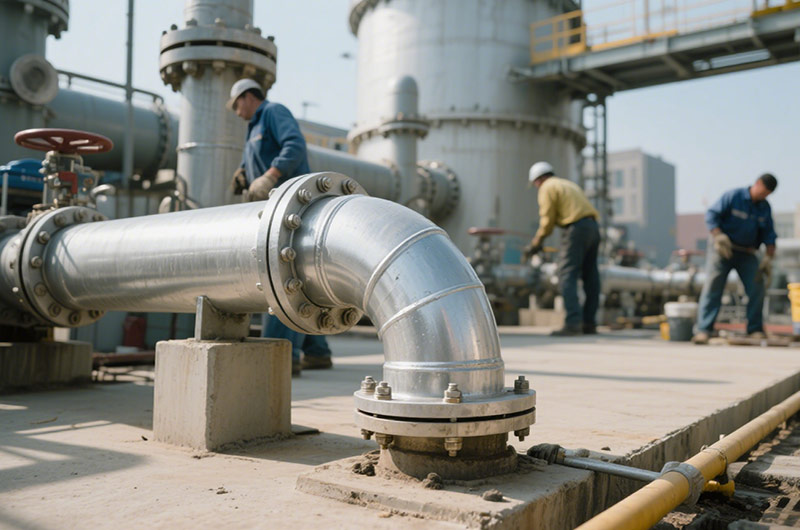
Application Cases in the Food and Beverage Industry
In the food and beverage industry, 4" aluminum elbows are mainly used in the following aspects:
- Food delivery systems: Used to transport raw and finished food products, especially in clean environments
- Beverage filling systems: Connect filling machines, storage tanks, and pipelines
- Dairy production: Connect various processing equipment and storage tanks
- Brewing industry: Connect fermentation tanks, storage tanks, and bottling lines
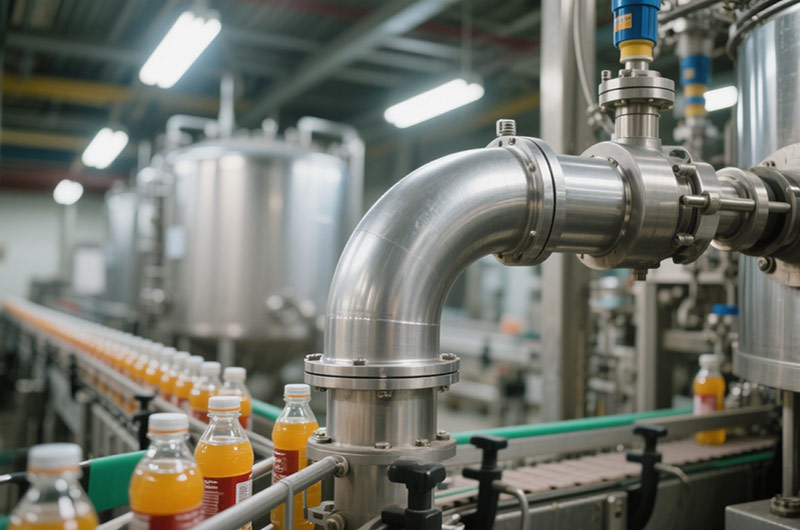
4 Aluminum Elbow Selection Guide
- Pressure rating: Aluminum alloys have lower strength than steel; ensure system pressure is within allowable range (usually marked as PN rating)
- Media compatibility: Avoid strong acids, strong alkalis, or highly corrosive environments to prevent material degradation
- Standard compliance: Select elbows based on pipeline standards (e.g., ASME B16.9, GB/T 12459) for dimensional compatibility
- Surface treatment: Some aluminum elbows are anodized or coated to enhance corrosion resistance; choose based on environment
Precautions
- Fit and compatibility: Ensure diameter and connection type (compression or flanged) match existing setup
- Material and gauge: Lightweight 26-gauge suitable for residential ventilation; thicker (16-gauge T6 aluminum) for industrial or high-performance use
- Installation environment: Indoor (e.g., dryers/vents) or outdoor/harsh conditions may require corrosion-resistant or high-performance alloys
Comparison with Elbows Made from Other Materials
| Material | Advantages | Disadvantages | Suitable Scenarios |
| Aluminum Alloy | Lightweight, corrosion-resistant, low cost | Lower compressive strength | Low-pressure, non-corrosive media pipelines |
| Carbon Steel | High strength, low price | Prone to rust | High-pressure, dry industrial pipelines |
| Stainless Steel | Excellent corrosion resistance, high strength | High cost, heavy weight | Chemical, food-grade, and corrosion-resistant applications |
Recommended for you
-
Our marine-grade 90-degree aluminum elbow products are certified by multiple international classification societies (DNV/ABS/CCS/BV), ensuring compliance with the stringent requirements of shipbuilding and marine engineering.
-
We offer marine-grade 45-degree aluminum elbows in a range of standard sizes including 2 inch, 3 inch, 4 inch, 5 inch, 6 inch, along with customized options such as Cast Aluminum 45 Degree Elbow.
